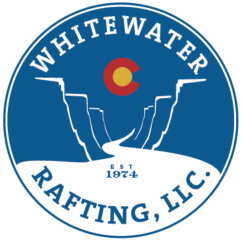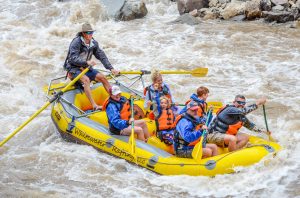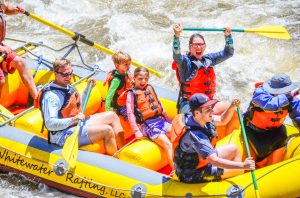What to Bring on a Whitewater Rafting Trip

Whitewater rafting is one of the most scenic, thrilling, and fun adventures you can do in the mountains on your vacation. What makes whitewater rafting so great is its versatility. Anyone can do it, thanks to guided tours. You don’t need a lot of experience if you take your trip with an experienced guide. But you may be wondering what you need to bring on your rafting trip and what will be provided by the rafting company. This can be especially true if it’s your first time rafting. This blog will key you in on what you should pack for your whitewater rafting trip.
Whitewater Rafting Basics
Before we dive into what you need to bring on a whitewater rafting trip, let’s talk briefly about a few variables – mainly the environment and weather conditions you may experience on your journey. First, most commercial rafting in the mountains happens from the late spring until the early fall. For example, rafting in the Rocky Mountains begins high in April and May as the winter snow starts to melt in the spring sun, filling the rivers with runoff. The water will be ice cold early in the season, even though the weather is warming up fast. As the spring and summer commence, and the runoff travels further down the mountain, the waters will warm considerably. By July and August, the waters are much warmer.
So, the time of year you decide to go can make a big difference. Whenever you go, expect a mix of sun and shade – and prepare to get wet. When you go whitewater rafting, there’s almost a 100 percent chance you’ll receive at least a mild soaking, if not considerably more.
Understanding River Classification Ratings
If you’re just starting, you will probably be rafting what’s known as Class I or II rapids. Class I routes are mild, scenic, and enjoyable. These are the easiest, most relaxed routes you can take. Class II runs are slightly more intense but still suitable for most families. A good Class II route will have mild spots and a few sections that are a little splashier. When you get to Class III rapids, the excitement and intensity increase. A Class III run is ideal for more athletic groups and adventure seekers who probably have been rafting a few times. Class IV and V rapids are for more advanced rafters seeking a big adrenaline rush.
Base Layer Essentials
When packing for your whitewater trip, start with your swimming suit. Plan to wear your swimming suit as your base layer rather than underwear. It’s important to avoid anything made of cotton because it absorbs water quickly and dries slowly. You don’t want to sit in soggy cotton boxers or briefs all day. Women should consider a two-piece swimsuit because it’s easier to use the bathroom than wearing a one-piece. While you shouldn’t wear cotton underwear in the water, pack a fresh pair of undies for the ride home.
On top of your swimsuit, consider comfortable, athletic clothing made of moisture-wicking fabric. Moisture-wicking fabric is soft and lightweight, repels water, dries fast, doesn’t wrinkle, and takes up less space in your pack. A good moisture-wicking shirt can significantly affect your comfort level on the river.
For bottoms, board shorts are an excellent option for men. Board shorts are made from quick-drying material and are a perfect choice in warm conditions. Water-resistant pants are an intelligent choice in colder conditions. Women should opt for tights with UPF 50 sun protection.
Life Jackets
Your rafting outfitter should provide you with a life jacket on guided rafting tours. Your guide can help you find the right fit and ensure it is tight and comfortable. While you should spend most of your time on the raft, you could end up in the water for a bit. Having a life jacket on will ensure you stay afloat and safe. You must keep your life jacket on the entire time. Remember, mountain rivers can change unpredictably, and good swimmers can be overwhelmed by a strong current.
Helmets
Your guide should also fit you for a helmet on a commercial rafting adventure and help you find the right size and fit. You must wear your helmet the entire time. If you fall in the water, it can keep you safe from rocks and other debris. It can also help protect you from an accidental head strike from someone else’s paddle.
Packing a sun hat or baseball cap before and after the river can also be brilliant. The sun can be intense in the mountain, so staying protected is crucial. This is especially true if you are bald, have a shorter haircut, or are fair-skinned.
When to Wear Long Sleeves
You may or may not want to pack a long-sleeved jacket. It depends on the weather. Of course, it never hurts to pack one, just in case. Again, stay away from cotton and pack a long-sleeved jacket that repels water and keeps you warm.
For extra warmth, you can also pack a sweatshirt, fleece, or mid-layer jacket. They can also help protect you from mosquitos in warmer weather. Even if you don’t use it on the river, it can come in handy after being in the water for relaxing and warming up.
Protect Your Feet
What kind of shoes you wear is also essential. Having shoes that protect your feet from the hazards of the river and the sun is vital. First, stay away from Crocs or flip-flops because they don’t provide enough protection, plus they can fly off in the water and get lost. Instead, opt for closed-toe sandals or bring along an older pair of tennis shoes that can get wet (or destroyed). Diving shoes are another excellent option.
Also, you won’t need cotton socks as they will weigh you down and hinder your moveability. Always pack a dry pair of shoes and socks for after the ride. Smartwool socks are comfortable and don’t get weighed down by moisture or sweat.
Other Rafting Necessities
Before you head to the river, make sure you’ve packed these rafting essentials:
- Polarized sunglasses: The sun can be bright in the mountains and reflect off the water and canyon walls. It’s important to have sunglasses with polarized lenses to amplify the color of your surroundings without hurting your eyes. Be sure to attach your sunglasses to a floatable strap so you can hopefully locate them if they fall off in the water.
- Water bottle with carabiner: Whitewater rafting can be hard work, so staying hydrated on your trip is essential. Pack your favorite water bottle, but include a carabiner clip. A carabiner is a metal clip that allows you to secure your water bottle to the raft so it doesn’t float away. A good size to bring is 3 or 4 inches long – the carabiner will need to clip through the loop on your water bottle and the strap on the raft. This will make it easier to access your water bottle throughout the day.
- Sunscreen: Take sunscreen with you and apply it throughout the day. The intense mountain sun can lead to sunburns, so lather up! These days, sunscreen comes in several forms. There’s an aerosol spray, roll-on, and the traditional cream. Aim for sunscreen with at least UPF 50 protection.
- Lip balm: Like sunscreen, lip balm will protect your lips from dryness and sunburn. Apply it throughout the day, even after your rafting trip has ended. Better safe than sorry!
- Cooling towel: Consider a cooling towel if you’re rafting in the heat. These neat little towels can be soaked in water and wrapped around your neck to keep you cool for an extended period. If it’s cold, you may not need it. But if it’s hot, you’ll be glad you brought it along.


